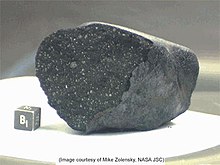Cubanite
[2] Cubanite is chemically similar to chalcopyrite; however, it is the less common copper iron sulfide mineral due to crystallization requirements.
[5] Upon its transformation to isocubanite it will lose its highly magnetic property due to its change from an orthorhombic to a cubic crystal structure.
Cubanite has been found in carbonaceous chondrite meteorites, specifically class CI-chondrites, as well as in cometary samples from NASA’s Stardust spacecraft.
Using a lab-based variant of hydrothermal recrystallization, temperatures between 150-200 °C, and a pH of 9, scientists were able to determine compositions needed to replicate CI-chondrite mineralogy.
Due to its complex growth nature, Cubanite has been the test subject for instrumental preference in copper isotope microanalysis.
It was found that ultra violet laser ablation multiple collector inductively coupled plasma mass spectrometry (UV-fs-LA-MC-ICP-MS) improves precision in respect to copper isotopes, when compared to the use of near infrared (NIR-fs-LA-MC-ICP-MS) methods.


